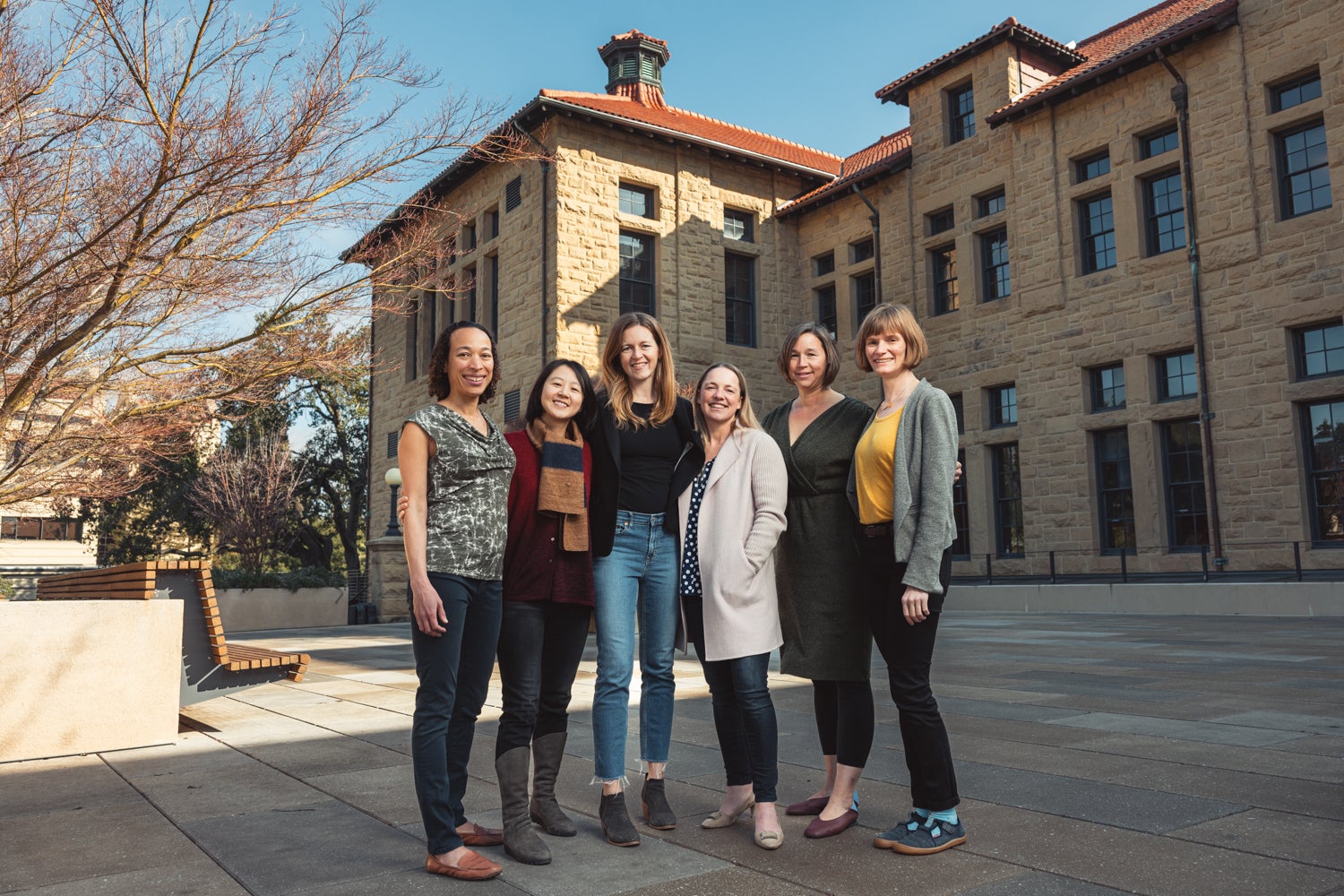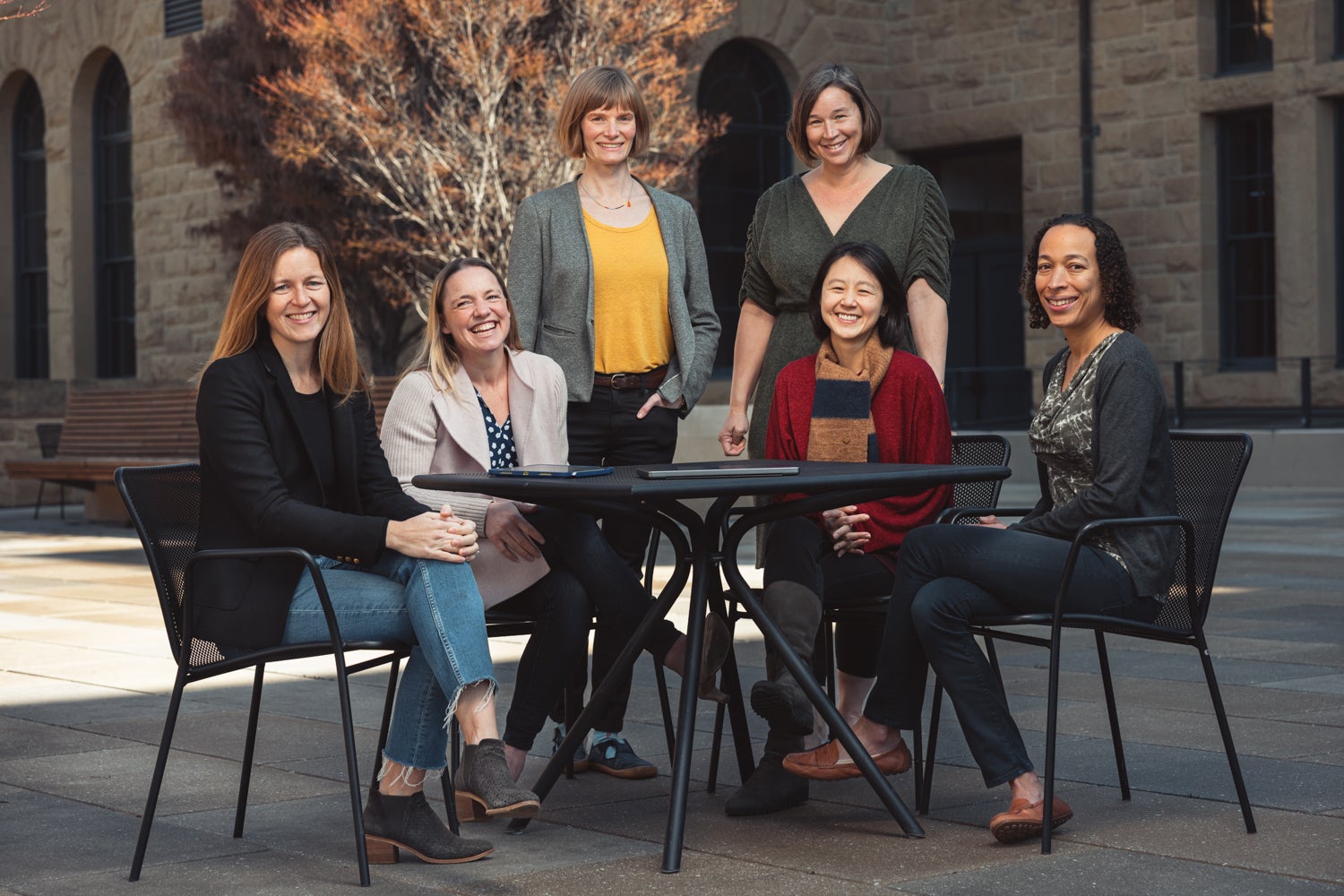In May 2016, six friends wound their way around the Stanford campus on an informal nighttime lab tour. The friends were six new faculty, and the labs were their own. What was designed as a three-hour “lab crawl” to share their research ended up stretching on for eight.

The “Stanford Six” (from left): Monika Schleier-Smith, Hyowon Gweon, Erin Mordecai, Alia Crum, Jessica Feldman, and Lauren Tompkins. (Image credit: Andrew Brodhead)
“Every time, 10 minutes turned to 45 because everyone had so many questions,” said Hyowon Gweon, associate professor of psychology, who joined Alia Crum, Jessica Feldman, Erin Mordecai, Monika Schleier-Smith, and Lauren Tompkins on the excursion. To these early-career faculty, the experience was akin to what incoming students go through: stoking the flames of burgeoning friendship while exploring their new campus and home.
“It’s daunting to start as an assistant professor at Stanford University,” said Crum, who is an associate professor of psychology. “It’s not just figuring out how to start a lab, hire staff, and recruit students, but also figuring out how to navigate life – buying a house, having kids, and creating community. To have each other to talk through those high-level problems, even though our research is very different, has been critical. It gives me a sense of belonging.”
These six people represent three different disciplines in Stanford’s School of Humanities and Sciences. They all began as junior faculty between 2013 and 2015. All are women, and when they started at Stanford, none had children. In the years since they met, they have supported each other through awards, grants, papers, tenure, relationship ups and downs, pregnancies, miscarriages, births, home buying, wildfires, heat waves, power outages, and of course, a pandemic – among many other life events.
For them, the takeaway has been not that they needed each other to reach new heights, but that the support, knowledge, and community they found in each other made the lows a little less low, the highs a little higher, and helped each of them feel like they belonged at Stanford.
“This group is important for so many reasons, but I think most crucially it is the group that made me feel at home at Stanford,” said Tompkins, an associate professor of physics. “I am proud to consider them my friends and colleagues, and that pride brings me a connection to campus that I don’t know that I would have otherwise.”
A professorial community
The entry into professorial life is often a busy chapter, personally and professionally, and it can be hard to make friends when you’re among a handful of new hires each year across the university. Even Stanford faculty can experience imposter syndrome and question whether they will fit in – or feel “smart enough” – said the group.
“As assistant professors coming in, you might have your guard up and wonder who you can be honest with about anxieties and problems and issues. Having people I can be honest with – friends I can talk to and complain with – is something I really value,” said Gweon.
“We all started around the same time and there is a lot you’re learning going from being a PhD student or postdoc to running a lab. There are official university events that address that transition but we also just like hanging out and talking about those things ourselves,” said Schleier-Smith, who is an associate professor of physics. “It’s important that we have fun, and we genuinely like each other.”
Some members of the group found each other through Stanford-sponsored events, like orientations and happy hours. Then, other connections were made in more casual settings. Crum, Mordecai, and Feldman met, for example, at the Stanford West apartments hot tub, and Feldman, Mordecai, and their partners would play basketball on the nearby courts.
“We used to joke about waking up the emeritus faculty at the nearby retirement community,” said Feldman, associate professor of biology. “It’s a very funny dynamic between being a junior faculty and students looking at you as this austere ‘professional’ – and then you’re also just running around having fun.”
A career in academia often entails blurred lines between personal life and work life. What’s considered professional can change as colleagues become friends – coming over for dinner, going out for drinks, hangouts that include spouses or children – and as faculty try to develop a sense of camaraderie with the staff and students in their labs.
For many of them, however, that blending of personal and professional worlds is part of the appeal of this work.
“It’s the sense of community, where you can really be yourself and be a person and not just be a professional all the time,” said Mordecai, who is an associate professor of biology.
Women navigating academia
The six friends did not set out to form a group of only women. Even so, the years-long friendship between six women faculty members is not a coincidence, and there has been concrete value in having this shared identity.

The six faculty members represent three different departments – biology, physics, and psychology – within the School of Humanities and Sciences at Stanford. (Image credit: Andrew Brodhead)
“It certainly wasn’t intentional to have this group be all women, but it equally wasn’t an accident,” said Tompkins. “Academia is male-dominated – my field is particularly male-dominated – and that leads to some shared experiences through which we can all bond.”
For example, a good portion of the group said the others helped them process and address experiences of sexism, which many said they hadn’t really confronted before.
“When you’re first dealing with sexism in individual situations or with individual people, you question it, or you don’t even see it. But when you step back, you start to see a pattern. Then, it’s really validating to have other people that can see it too, and who have been through it,” said Mordecai.
The group acknowledges their debt to past women scientists and women in other high-powered jobs, and they hope that they in turn can serve as an inspiration and as examples for others.
“There’s still a stigma that women are making the tradeoff between a life and a profession. I think all of us exemplify the fact that you can have both,” said Feldman. “It’s not like we just gave up everything for this job. We all still maintain multifaceted personalities and lives. That’s a really important thing to portray, especially for young women.”
Trials and successes
In the years since the lab crawl, all six of these researchers have gone from being junior faculty to earning tenure. They all described that milestone as an overall positive experience but, noted Crum, “We’re talking about our experiences after having received tenure. It’s always more glorious in retrospect. I’m sure each of us could go back and remember a time that was hard. There could have been a breaking point if there wasn’t a person to talk to, be vulnerable with, and learn from.”
Coming into Stanford, many of the six had never taught their own classes or managed their own teams. Their new positions, at this stage of their lives, mean they’ve had to be bosses, researchers, and teachers while also being people who are trying to put down roots and grow families. It’s exciting, but far from easy.
“I think sometimes people who are not professors assume that professors have this hardened shell. But it affects you when someone gets upset with you as a boss or says you didn’t do a good job advising them,” said Mordecai, who recalled a long, late-night talk with Crum about a challenging time early in her lab. “Ali really helped me to understand it as a growth opportunity. She had some comparable stories from her and her friends’ lives that gave a bigger-picture perspective without trivializing it.”
Even now, as everyone in the group is considered a “mid-career” researcher (thanks to tenure), they still seek counsel on their group chats.
“What comes up most now is, ‘I got asked to do X. Should I do X?’” said Schleier-Smith, highlighting the many and varied requests made of faculty, such as taking part in department and university committees, organizing conferences, and serving as editors for journals or board members for scientific societies. “It’s nice that we can also offer perspectives from different disciplines. My lab is full of lasers, and Hyo creates customized toys to do experiments with children, but we still learn from each other.”
These friends have often been inspired by each other’s successes – sharing tips for grant proposals, sitting in on each other’s classes, and even attempting to collaborate on research projects. They also, happily, take every opportunity to send kudos.
“Just recently, we saw Erin in Stanford Report and Monika on NPR. Those got shared around and we all celebrated them,” said Gweon.
“I look at my friends and am amazed by who they are, the research they are doing, and all that they are juggling along the way,” Crum said. “And it makes me feel immense pride, gratitude, and joy to be doing what I do. I’ve gravitated to these women not just to complain about problems together, but to be inspired by them and to solve problems – our own and the world’s.”
To read all stories about Stanford science, subscribe to the biweekly Stanford Science Digest.